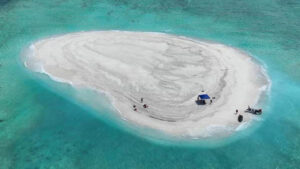Philippines says China aircraft carrier did flight deck operations near coast

By Kenneth Christiane L. Basilio and Adrian H. Halili, Reporters
THE Philippine Navy on Monday said a Chinese aircraft carrier that it spotted near its northern coast practiced take-off and landing drills, probably in response to military exercises between the Southeast Asian nation and treaty ally the US under their annual Balikatan (shoulder-to-shoulder) war games.
The Chinese Shandong-class aircraft carrier, escorted by a warship, carried out flight deck operations about 123 nautical miles (228 kilometers) off Ilocos Norte province on April 25, Philippine Navy spokesman Rear Admiral Roy Vincent T. Trinidad told a news briefing on Monday.
“The presence of the Shandong carrier battle group is in response to what is happening between the Armed Forces of the Philippines (AFP) and other partner countries for Balikatan,” he added.
The Philippine Navy last week monitored the Chinese aircraft carrier, six escort ships and a spy ship sailing in the Luzon Strait, where Philippine and US forces are conducting week-long military exercises that feature an advanced US anti-ship missile system.
The military drills are being held in Philippine areas facing regional hotspots such as the South China Sea and Taiwan. They involve more than 14,000 troops from 20 nations and will run until May 9.
Started in 1991, the Balikatan exercise has evolved into Southeast Asia’s premier combat rehearsal as the Philippines and the US seek to strengthen security cooperation and enhance force interoperability in response to China’s growing assertiveness in the region.
The US last week deployed its Nimitz aircraft carrier group to the Philippine Sea, where it is practicing day and night flight operations and testing its ability to rapidly deploy military jets in various weather conditions, according to the US Indo-Pacific Command.
Also on Monday, the Philippine military said it held an air defense capability training in Zambales province at the weekend where advanced weapons such as ground-based air defense systems were deployed.
The Philippines’ Spyder air defense system and US Marine Air Defense Integrated System shot down several air drones in the Naval Education, Training and Doctrine Command base in the province facing the South China Sea.
“During the exercise, AFP and US personnel collaborated to sense and engage targets,” it said in a statement. “These systems are designed to detect airspace intrusions and enhance overall force protection for both Philippine and US units.”
PEDDLING ‘LIES’Meanwhile, the Philippines denied reports that said Beijing had seized control of a disputed reef in the South China Sea.
“There is no truth whatsoever to the claim of the Chinese Coast Guard that the Pag-asa cays have been seized,” National Security Council spokesperson Jonathan E. Malaya separately told a news briefing, using the Philippine name for Sandy Cay Reef. “The facts on the ground do not support this statement coming from the Chinese Coast Guard.”
The Chinese Embassy in Manila did not immediately reply to a Viber message seeking comment.
Chinese state media last week reported that the Chinese Coast Guard had asserted sovereignty over the Sandy Cay — a small coral reef west of Thitu Island (Pag-asa Island) on the northern side of Thitu Reefs of the Spratly Islands — by landing and displaying China’s national flag on the sea feature.
The Philippines has been occupying Thitu Island, where it has a military outpost and where a small community of Filipinos lives, since 1971.
Mr. Malaya urged Beijing to refrain from escalating tensions in the already volatile waters by claiming unoccupied features.
“It is not to the benefit of any nation if these things are happening, nor is it to the benefit of any nation if such irresponsible announcements and statements are released to the public,” he said.
“We urge the People’s Republic of China and the Chinese Coast Guard to maintain the status quo in the West Philippine Sea, consistent again with the 2002 Declaration of Conduct,” he added, referring to parts of the South China Sea within the nation’s exclusive economic zone.
Senator Ana Theresia “Risa” N. Hontiveros-Baraquel urged the Foreign Affairs department to file a diplomatic protest over China’s alleged incursion into Sandy Cay.
“Our government should take appropriate action to safeguard our claim,” she said in a statement. “If we don’t, this might even undermine our presence on Pag-asa Island.”
Foreign Affairs spokesperson Ma. Teresita C. Daza did not immediately reply to a WhatsApp message seeking comment.
The senator also called on the Philippine Coast Guard to intensify its joint patrols over the area. “China’s unacceptable behavior not only violates international law, it also further keeps Filipino fisherfolk away from waters they should have access to.”
“The photoshoot gimmick and supposed planting of the Chinese flag on Sandy Cay is just another spectacle orchestrated by Beijing. No self-respecting state would take it to mean that China now has sovereign rights over it,” she added.
She said Sandy Cay belongs to the Philippines and “no amount of island hopping by the Chinese Coast Guard will muddle the truth.”
Separately, Senator Jose “Jinggoy” P. Ejercito Estrada said the Sandy Cay incident is another attempt by China to “distort the reality” and “spread fake news.”
“We must stay vigilant and resolute in protecting our sovereignty and maritime rights,” he said in a statement. “I urge our relevant agencies to clarify the situation and ensure that any actions violating our territorial integrity are addressed the soonest possible time.”
Beijing and the Association of Southeast Asian Nations (ASEAN) have yet to finalize a code of conduct in the hotly contested sea decades after signing a nonbinding 2002 declaration, which called on parties to “exercise self-restraint in the conduct of activities that would complicate or escalate disputes and affect peace and stability” at sea.
The South China Sea has become a flashpoint in Southeast Asia as China continues to assert sovereignty over almost the entire sea, seen as a vital global trade route that is also believed to be rich in undersea gas and oil deposits.
Beijing has deployed an armada of coast guard vessels to protect what it considers its territory despite a 2016 arbitral tribunal ruling that voided its claim for being illegal.
Philippine Foreign Affairs Secretary Enrique A. Manalo last week said ASEAN and China are “politically committed” to finalize the proposed code of conduct next year, when the Philippines hosts the ASEAN.
Philippine Coast Guard spokesman Jay Tristan Tarriela accused China of peddling “lies” about claiming sea features.
“We can already observe how the Chinese government plans out their strategy,” he told the same briefing. “It always starts with a lie.”
“If we’re not going to counter the lie, they’re going to operationalize that lie and take possession of whatever narrative that they have,” he added.




